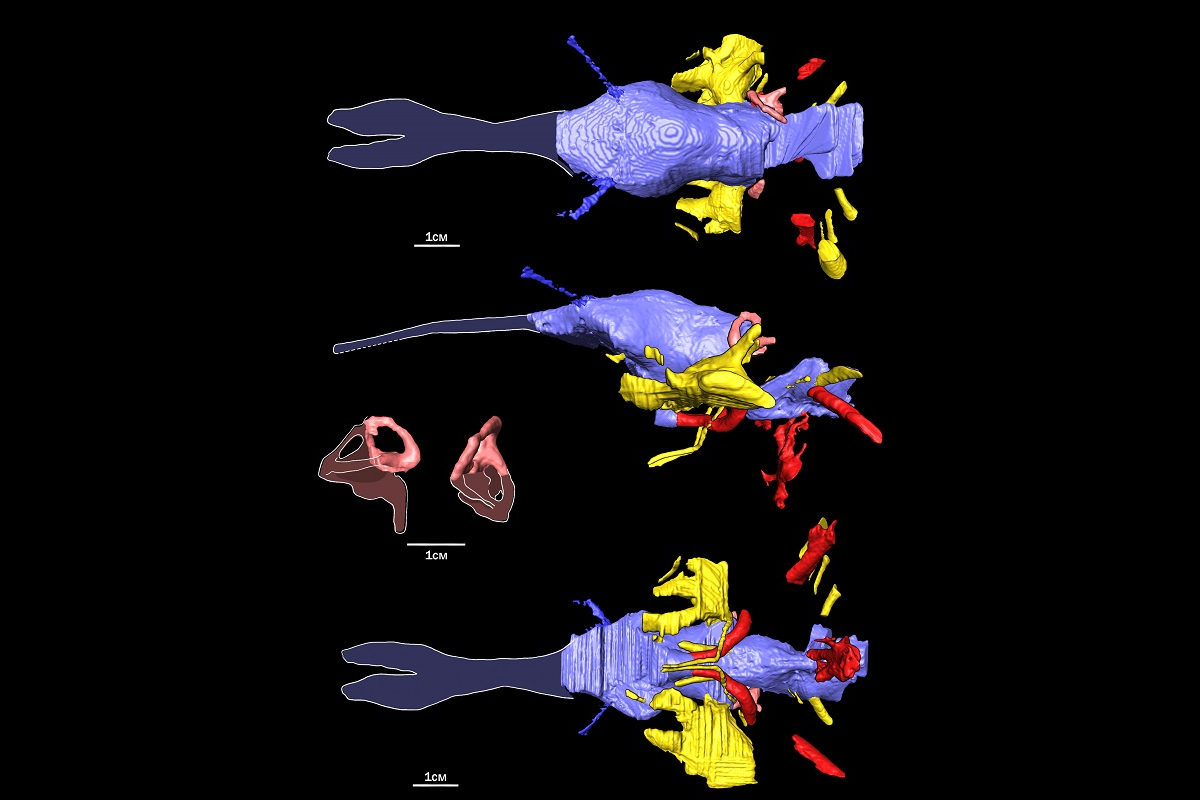St Petersburg University palaeontologists model a braincase of an ancient relative of modern crocodiles
Scientists from St Petersburg University, the Zoological Institute of the Russian Academy of Sciences, the Research Institute of Artificial Intelligence, and Sechenov University have described the braincase osteology and neuroanatomy of a paralligatorid crocodylomorph Kansajsuchus extensus based on 3D‑modelling. The project is part of the grant of the Russian Science Foundation. This ancestor of modern crocodiles had similar cognitive abilities.
Crocodylomorph Kansajsuchus extensus (Kansajsuchus) is one of the largest representatives of the extinct family of paralligatorids. It reached 4 to 5 metres in length, while some individuals could grow up to 7 metres. It lived in a large river in a locality in Tadzhikistan about 85 million years ago.
The research findings are published in Cretaceous Research..
For a long time, Kansaisuha had been classified as a species of Goniopholididae. Yet, in 2019, scientists from St Petersburg University proved that it belongs to Paralligatoridae. They are a completely extinct group of crocodylomorphs, close to the common ancestor of all modern crocodiles. They existed in Asia during the Cretaceous period (~130‑66 million years ago). Their appearance and lifestyle were similar to modern relatives. They were semiaquatic predators.
Kansajsuchus was first described in 1975 by Moscow palaeontologist Mikhail Efimov (Borissiak Palaeontological Institute of the Russian Academy of Sciences). The remains of this crocodylomorph were found near the village of Kansai in Tajikistan in the 1960s during several expeditions led by Moscow palaeontologist Anatoly Rozhdestvensky. Today, the materials are stored in the collection of the Orlov Palaeontological Museum in Moscow.
‘We described the bones of Kansajsuchus in 2019, but the internal structure of its braincase remained unknown. Our new study is based on CT‑scanning and 3D‑modelling, where we examined three skull fragments, including almost the entire braincase. We created 3D‑models of braincase. Otherwise, its study was not possible’, said Ivan Kuzmin, Associate Professor in the Department of Vertebrate Zoology at St Petersburg University.
The scientists produced casts (endocasts) of the internal cavities in the braincase, which was occupied by the brain, nerves, blood vessels, sensory organ (inner ear) and pneumatic sinuses. These data enabled the scientists to gain a deeper understanding of the neuroanatomy of Kansajsuchus.
This project continues a series of projects on the evolution of the braincase and neuroanatomy of crocodiles and their fossil relatives that a team of palaeontologists from St Petersburg University has been conducting for many years. Previously, they described for the first time all the structures of the brain of modern crocodiles, having studied more than 70 of their 3D models. They also identified the oldest ancestor of modern crocodiles from a skull found in Portugal.
ПThe palaeontologists compared the bones and casts of the braincase cavities of Kansajsuchus with other extinct crocodylomorphs and modern crocodiles. It was possible to trace how the bones of the braincase changed during the evolution of crocodylomorphs up to modern species. The brain and nerves of Kansajsuchus turned out to be similar to those of modern crocodiles. Their cognitive abilities were at the level of living relatives, the scientists believe.
The study is part of the project ‘Neuroanatomy of crocodylomorphs (Archosauria: Crocodylomorpha) and choristoderes (Diapsida: Choristodera): studying brain and skull evolution in diapsid reptiles with the aid of modern techniques’, supported by a grant from the Russian Science Foundation. St Petersburg University is the leader in the number of the grants of the Russian Science Foundation. In 2022, St Petersburg University scholars received 112 grants. This is 5.5% of the total number of winning projects and the largest number of grants per organisation. In 2023, the University retained its leadership in the competition of the Russian Science Foundation. St Petersburg University scholars received 70 grants, which is 5% of the total number of the winning projects.
St Petersburg University, the oldest university in Russia, was founded on 28 January (8 February) 1724. This is the day when Peter the Great issued a decree establishing the University and the Russian Academy of Sciences. Today, St Petersburg University is an internationally recognised centre for education, research and culture. In 2024, St Petersburg University celebrates its 300th anniversary.
The plan of events during the celebration of the anniversary of the University was approved at the meeting of the Organising Committee for the celebration of St Petersburg University’s 300th anniversary. The meeting was chaired by Dmitry Chernyshenko, Deputy Prime Minister of the Russian Federation. Among the events are: the naming of a minor planet in honour of St Petersburg University; the issuance of bank cards with a special design; and the branding of the aircraft of the Rossiya Airlines to name just a few. To mark the 300th anniversary of St Petersburg University, a postage stamp depicting the Twelve Collegia building and the monument to Count Sergey Uvarov was issued. Also, a Soyuz rocket bearing the symbols of the University was launched from the Baikonur Cosmodrome.
By the decision of the Governor of St Petersburg Alexander Beglov, 2024 is a year of the 300th anniversary of St Petersburg University in St Petersburg. On the day of the University’s 300th anniversary torches were lit on the Rostral Columns on the Spit of Vasilyevsky Island. St Petersburg University flags were raised on the Palace Bridge. The city public transport was decorated with the University’s symbols. During St Petersburg’s City Day celebrations in May 2024, St Petersburg University acted as a participating venue. Additionally, the University has launched a website dedicated to the anniversary. The website contains information about outstanding University staff, students, and alumni; scientific achievements; and details of events held as part of the celebration of the 300th anniversary of the University.




